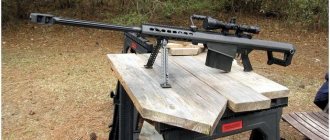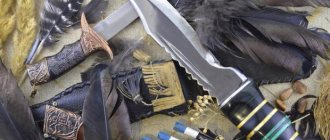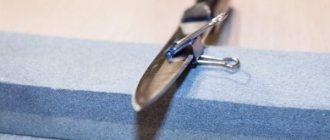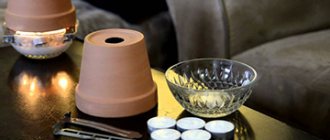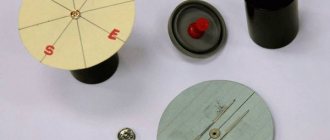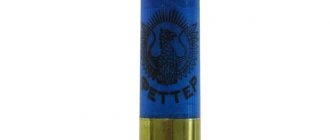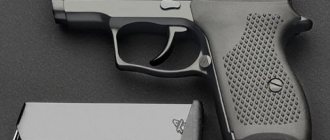Loading a cartridge with a container
Initially, the shot container was intended to increase shot accuracy. Now manufacturers are mass-producing container wads that contain a seal, a shock absorber and the container itself. They have a number of advantages. The plastic seal does an excellent job of preventing the breakthrough of powder gases; the shock absorber slightly smoothes out the pressure surge in the chamber, which helps maintain the shape of the shot cloud. The container's polyethylene cup prevents contact of the shot with the walls of the barrel, preventing it from deforming and reducing lead in the barrel.
Loading cartridges with a container is no different from usual, except for greater convenience and speed.
Container selection rules
- The size of the container must match the weight of your shot, it all must fit in the container
- The height of the container should match your cartridge and packaging method.
- The shock absorber and seal must be strong to avoid their deformation and distortion of the container when packing or firing.
We listed the equipment for equipment earlier, now we will focus on the order of the nuances of equipping a cartridge with a container.
Classification of hunting ammunition
The choice is determined by two main parameters - the type of game and the characteristics of the gun. The cost is influenced by the material of manufacture and the manufacturer. Most domestic cartridges meet international quality standards, but some hunters still prefer foreign analogues.
The following classification of these ammunition is accepted:
- By type of gunpowder: smoky or smokeless. The former are practically not produced due to poor performance.
- Sleeve material: plastic, paper or metal. Cartridges with a plastic body have proven themselves well.
- Type of charge: buckshot, shot or bullet. The choice depends on the characteristics of the future prey and shooting conditions. For hunting birds, ammunition with shot is used, less often with buckshot.
- Classification of fractions. It can be steel or lead, the size varies from 1.5 mm to 5 mm.
- Sleeve length. Shot - 65, 70, 76 and 89 mm, buckshot - 65, 70, 76 mm.
Magnum cartridges with increased pressure of powder gases during a shot are used less frequently. Not all hunting rifles are designed for such conditions.
Read about loading your own cartridges here.

Ammo calibers
There are two definitions of caliber:
- bullet diameter;
- the diameter of the bore of a weapon.
The calibers of hunting cartridges in numerical values coincide with the bore of the weapon. Moreover, the calibers of smooth-bore and rifled weapons differ somewhat in markings.
Smoothbore guns are calibrated with an even integer: 4, 8, 10, 12, 16, 20, 24, 28, 32, 36. The most popular calibers in the world are 12, 16, 20, 28, 32 and 36. Ammunition for him - 16 gauge hunting cartridges. This gradation makes it easy to select shells for your weapon.
The caliber of a rifled weapon is determined to hundredths of a millimeter. In English-speaking countries, they count in inches. For example 7.62 mm or 5.6 mm. Shells are calibrated in the same way - 7.62 hunting cartridges. The diameter of a rifled weapon bullet must necessarily correspond to the diameter of the barrel. Then the bullet acquires rotational motion.
It’s hard to make a mistake with the standard size, but you have to be careful with the selection of bullets. English-language labeling requires certain knowledge. The choice depends on the purpose of the charge; it should have the best accuracy at maximum range or maximum stopping effect, what kind of game the hunter will catch - small or large. The marking will tell you the best option.
Loading a cartridge with a bullet
Loading 12-gauge cartridges at home with a bullet must be done with special care, because if, when shooting with shot, you can count on the scope of flying lead, then there is only one bullet, and the trajectory of its flight should be as precise as possible. To achieve this, ammunition must be loaded responsibly and correctly.
The sequence of assembling a cartridge using a bullet is very similar to the version with shot, the only difference is in the projectile. The bullet must be free of damage, cracks and deep scratches. Some hunters load 12-gauge ammunition with 16-gauge bullets. In this case, the bullet in the case must be centered. You can use a piece of 16-gauge cardboard sleeve for this. It should be located exactly in the center; for this, it is lined on three sides with suitable retaining material (threaded parts of the same sleeve).
How to load 12 gauge bullets and buckshot
To load a 12-gauge cartridge, 1.8 g of “Sunar”, 2.1 g of “Falcon” or 7 g of “Bear” are loaded. Gasket – 2 mm. Wads: felt and fiberboard.
Loading 12 gauge cartridges with a bullet is carried out as follows. The main felt wad and the additional one are installed so that 5 mm remains for rolling. They put the bullet on the wads and roll it.
When loading 12 gauge bullet cartridges, use the general rules
.
To load 12 gauge cartridges with buckshot, use 8mm buckshot. Sawdust is poured onto the wads or cardboard pad to the brim. They lay down 4 buckshots and push them in with a warrior.
Then they repeat the same thing. For the third time, three buckshots are laid. Then the gasket is installed. The cartridge is screwed in. For compact shooting, only 9 buckshots are stacked in groups of 3.
How to load 12 gauge cartridges
The process itself does not take much time, but requires attention and accuracy from its participant. Self-equipping 12-gauge bullet cartridges has a lot of advantages; it’s not for nothing that experienced hunters equip entire workshops at home (Figure 1).
The method is universal for shot, buckshot and bullet units - it is easy to learn, and hand-rolled cartridges last much longer than those packed with a star.
In addition, when fired, the ammunition creates less internal pressure, which makes it less harsh and extends the life of older barrels, which can be damaged by excessive muzzle impact.
To complete the task, you will need special equipment for loading 12-gauge cartridges, which includes certain devices and materials:
- The first include scales with a set of weights, dispensers and measures for gunpowder and pellets, stands for shells, and a guard for delivering wads.
- The second includes charging units, wads, gaskets, gunpowder and primers.
- It is worth highlighting some devices separately - UPS, a tool for rolling sleeves.
In the process of work, it is necessary to adhere to certain rules; the peculiarities of equipping 12-gauge cartridges are that the activity itself is difficult and dangerous, so it must be carried out in a prepared place so that there are no unnecessary objects on the work table. A similar condition is the absence of strangers; for beginners, it is worth doing business in the company of an experienced person.

Figure 1. Loading ammunition requires care and concentration.
Concentration and attentiveness are the main criteria for your safety and success; you should never smoke during the exercise.
Traumatic cartridges with rubber bullets
The bullet used to load a traumatic weapon for self-defense cannot cause serious injuries if the shot is not fired at point-blank range. The ammunition may not have buckshot inside, but several balls of pressed raw materials. If you shoot from a decent distance, then the threat to life is completely eliminated. Rubber bullet ammunition may contain two to four pellets, depending on the manufacturer. The average bullet weight does not exceed 4 g. Most shooters consider buckshot to be a more effective ammunition compared to rubber bullets.
| Name | Caliber | Bullet speed m/s at a distance of 3.5m | Muzzle energy | Features of the bullet |
| NVP "Ecologist" | 12 | 140 | 82.32J | The bullet was cast with defects. It is prohibited to use ammunition at a distance of less than 20 m. |
| Tekhkrim LLC | 12 | 140 | 79.32 J | Each bullet contains three rubber balls. It is prohibited to use closer than 10 m. |
| Barrier LLC | 12 | 140 | 83.99 J | The sleeve is imported. The quality is high. Shooting at a distance of no closer than 10 m. Bestseller. |

The main problem with “rubber cartridges” is the unpredictable power of the shot.
Due to the weak weight, which is uncharacteristic for use in such weapons. The use of such products by experienced shooters is not recommended due to the rather weak effectiveness of the ammunition. Rubber shot has its advantages. During firing, the weapon does not create serious noise, unlike buckshot.
Bullet Lee
Belongs to the sub-caliber category. It gained wide popularity among hunters due to the fact that the manufacturing company Lee actively distributed its cheap tools, including a watering can for this model. Its main characteristics: inexpensive, easy to implement, lightweight.
There are two variations of the Lee model, the main differentiating factor being weight. The popular name for the bullet – “cap” – describes its shape for itself. For rigidity, an internal rib is built into its design.
Buckshot
The shot is above 5mm. Necessary for hunting large animals, such as roe deer. It is recommended that the buckshot be kept in a container. There is a concept of matched buckshot. This is when buckshot is placed in layers in a cartridge and the shot follows each other. To achieve this, use cups for laying in rows. But manufacturers don’t bother too much about this issue and arrange it as they please.
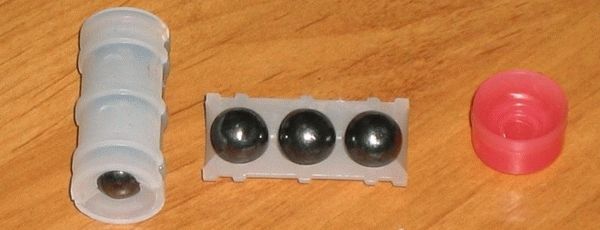
It is used exclusively for large animals: wild boar, roe deer, elk, etc. It may be a ball, but they are not very effective at long distances.
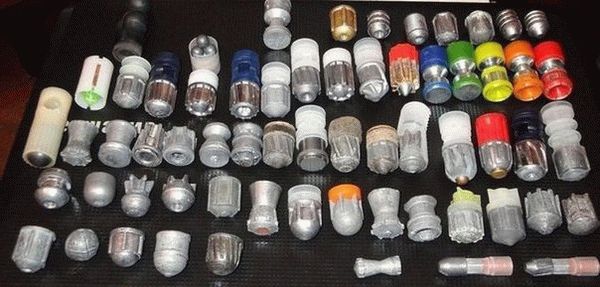
Component Selection
To equip cartridges you will need:
- plastic or metal (brass) sleeves;
- capsules;
- powder;
- wads;
- shot, buckshot or bullets;
- for loading cartridges in metal casings - plastic plugs for shot.
It must be borne in mind that to make 12-gauge cartridges in brass, you need to take 10-gauge wads and spacers.
Which sleeves to choose, plastic or brass? The second ones cost about 10 times more. But at the same time, metal sleeves turn out to be much more durable, and plastic sleeves will sooner or later become unusable. But, for example, a star twist allows you to use plastic sleeves at least 10 times, so their use is more than justified.
It should also be borne in mind that cartridges with brass casings cannot be fired from a repeating gun, since the barrel tube can be damaged by shot if some of it spills out.
It would also be useful to use varnish, which can be used to attach primers and seal them, since they fit into spent cartridges very easily. You can use water-soluble acrylic varnish, which is odorless. Floor or nail polish is also suitable. You can also use glue, for example, “Moment”.
Among the gunpowders, Falcon is very popular. It is inexpensive, but it also has a serious drawback - it does not burn out completely, so it heavily contaminates the gun.

